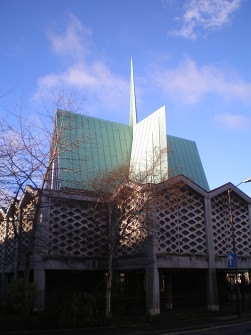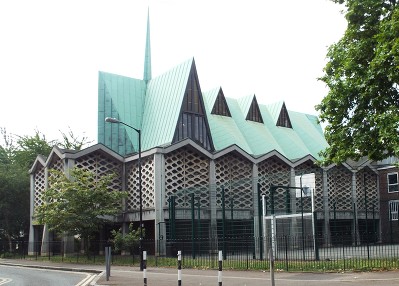





Exploring Southwark and discovering its history


County Council in the mid 1950s, it combined both bomb and slum clearance with some restoration of Victorian terraces and included six newly built 18-storey blocks. A new church was built which was designed to be in keeping with the new contemporary architecture of the estate by the practice Woodroffe, Buchanan and Coulter. The new church was consecrated in 1960 and, now Grade II listed, it very much reflects the architecture of the times. It uses a mix of materials that includes brick and copper, and stained glass windows are integrated into a concrete honeycombed frame. The building also includes rubble and stone from the old church.
Unusually, the main church area and the church hall is on the first floor as the ground floor was set aside for community activities initially with an emphasis on youth work. In 1959, in response to press outrage at the exploits of teddy boys and other so-called juvenile delinquents, the government commissioned the Albemarle Report that examined how young people’s energy could be harnessed and channelled constructively and violent, anti-social behaviour contained. The report concluded that local authorities should become responsible for providing facilities for youth activities in partnership with voluntary organisations. The Crossed Swords Youth Club at St Paul’s represented the first such partnership between local government and the church.
The Youth Club ran successfully until the 1980s when, under the Thatcher government, there were reductions in public funding, and the centre closed. Canon Grahame Shaw, who was vicar at St Paul’s for 34 years, influenced by the Church of England report of 1985 entitled “Faith in the City”, opened a drop-in centre in the former youth centre space for those with mental health problems. It developed to such an extent that by 2005 it had a £1million pound budget, employed 20 staff and had administrative offices that included 4 counselling rooms in Walworth Road. The centre closed in 2008 when its services were transferred to Certitude a larger charity that offered greater opportunities.
St Paul's, Lorrimore Square
The parish of St Mary’s Newington can trace its history back to the 13th century, but as the population of London exploded in the 19th century it became necessary to build new churches to cater for the increased congregation. Holy Trinity Newington and St Peter’s Walworth were consecrated in 1826 and St Paul’s in Lorrimore Square was completed in 1856. It was built on land donated by the Dean and Chapter of Canterbury and designed by Henry Jarvis in the Victorian Gothic style.
The whole area suffered huge bomb damage during World War II and the church, with the exception of the steeple, was destroyed by an incendiary bomb in May 1941. The Brandon Estate was built on the surrounding area as part of post-war regeneration. Designed by the London


The 20th Century Society website has an article regarding the architecture of St Paul's Lorrimore Square.
The Shaw Wildlife and Sensory Garden was opened in 2012 in adjoining Lorrimore Square Gardens. It was created by local residents to honour Canon Graham and Adrienne Shaw.

Web discoveries
- UK Casino Not On Gamstop
- UK Casino Not On Gamstop
- Non Gamstop Casino
- Casinos Not On Gamstop
- Non Gamstop Casinos
- Non Gamstop Casinos
- Non Gamstop Casino
- Casino Sites Not On Gamstop
- Slots Not On Gamstop
- Casinos Not On Gamstop
- UK Betting Sites Not On Gamstop
- UK Casino Not On Gamstop
- Best Non Gamstop Casinos
- Betting Sites
- Non Gamstop Casino Sites UK
- Best Non Gamstop Casinos
- Non Gamstop Casino
- Casinos Not On Gamstop
- Non Gamstop Casino Sites UK